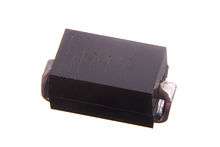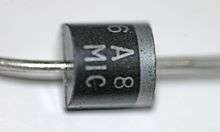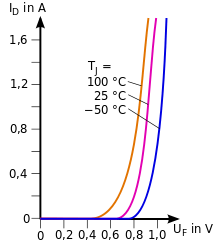1N400x general-purpose diodes
The 1N400x (or 1N4001 or 1N4000[2]) series is a family of popular one-ampere general-purpose silicon rectifier diodes commonly used in AC adapters for common household appliances. Its blocking voltage varies from 50 volts (1N4001) to 1000 volts (1N4007). This JEDEC device number series is available in the DO-41 axial package,[3][4] and similar diodes are available in SMA and MELF surface mount packages (in other part number series).[5][6]




The 1N540x (or 1N5400) series is a similarly popular family of diodes for higher-current 3 A applications. These diodes are typically available in the larger DO-201AD axial package to dissipate heat better.[7][8]
History
The 1N400x series was originally introduced by Motorola's Semiconductor Products Division and registered at JEDEC in 1963, as silicon power rectifiers primarily for military and industrial applications.[9] It appeared in the Motorola Semiconductor Data Manual in 1965, as replacements for 1N2609 through 1N2617.[10] The 1N540x series were announced in Electrical Design News in 1968, along with the now lesser known 1.5 A 1N5391 series.[11]
Overview
These devices are widely used and recommended for general-purpose power-frequency rectifier use.[12][13] They are commonly used as rectifiers in AC adapters of electrical appliances to convert AC to DC,[14] and are also used in other types of power converters,[3] or as freewheeling diodes to protect circuits from inductive loads.[3]
These are fairly low-speed rectifier diodes, being inefficient for square waves of more than 15 kHz.[15] They are not designed for switching applications; datasheets often don't specify any information on their turn-on and turn-off characteristics.[16]
Compared with signal diodes, rectifier diodes generally have higher current ratings, can have much higher reverse voltage ratings, but have higher leakage current and greater junction capacitance.[17]
The following table lists part numbers in the 1N400x, 1N540x, and other popular general-purpose silicon rectifier diode families.
| Voltage | Through-hole axial package | Surface-mount package | ||||||||||
|---|---|---|---|---|---|---|---|---|---|---|---|---|
| 1 A (DO-41) | 1.5 A (DO-15) | 3 A (DO-201AD) | 6 A (R-6) | 10 A (R-6) |
1 A (MELF) | 3 A (MELF) | 1 A (SMA) | 1 A (SMA) | 2 A (SMB) | 3 A (SMC) | 5 A (SMC) | |
| 50 V | 1N4001 | 1N5391 | 1N5400 | 6A05 | 10A05 | SM4001 | SM5400 | M1 | S1A | S2A | S3A | S5A |
| 100 V | 1N4002 | 1N5392 | 1N5401 | 6A1 | 10A1 | SM4002 | SM5401 | M2 | S1B | S2B | S3B | S5B |
| 200 V | 1N4003 | 1N5393 | 1N5402 | 6A2 | 10A2 | SM4003 | SM5402 | M3 | S1D | S2D | S3D | S5D |
| 400 V | 1N4004 | 1N5395 | 1N5404 | 6A4 | 10A4 | SM4004 | SM5404 | M4 | S1G | S2G | S3G | S5G |
| 600 V | 1N4005 | 1N5397 | 1N5406 | 6A6 | 10A6 | SM4005 | SM5406 | M5 | S1J | S2J | S3J | S5J |
| 800 V | 1N4006 | 1N5398 | 1N5407 | 6A8 | 10A8 | SM4006 | SM5407 | M6 | S1K | S2K | S3K | S5K |
| 1000 V | 1N4007 | 1N5399 | 1N5408 | 6A10 | 10A10 | SM4007 | SM5408 | M7 | S1M | S2M | S3M | S5M |
| Datasheet | [3][4][18] | [19] | [7][8][20] | [21][1] | [22][23] | [6] | [24] | [5] | [25] | [26] | [27] | [28] |
References
- "6A05 Datasheet" (PDF). Master Instrument Corporation (MIC). June 2017. Archived (PDF) from the original on 27 February 2018. Retrieved 27 February 2018.
- Though some writers and datasheets refer to "1N4000 series", a 1N4000 is a 10-watt Zener diode unrelated to the 1N4001 series of 1 ampere rectifiers.
- "1N4001 Datasheet" (PDF). Vishay Intertechnology. February 2018. Archived (PDF) from the original on 27 February 2018. Retrieved 27 February 2018.
- "1N4001 Datasheet" (PDF). ON Semiconductor. October 2012. Archived (PDF) from the original on 23 February 2018. Retrieved 22 February 2018.
- "M1 Datasheet" (PDF). Diotec Semiconductor. December 2016. Archived (PDF) from the original on 23 February 2018. Retrieved 22 February 2018.
- "SM4001 Datasheet" (PDF). Diotec Semiconductor. December 2015. Archived (PDF) from the original on 23 February 2018. Retrieved 22 February 2018.
- "1N5400 Datasheet" (PDF). Vishay Intertechnology. February 2018. Archived (PDF) from the original on 27 February 2018. Retrieved 27 February 2018.
- "1N5400 Datasheet" (PDF). ON Semiconductor. May 2008. Archived (PDF) from the original on 23 February 2018. Retrieved 22 February 2018.
- "Announcement of Electron Device Type Registration, Release No. 4190". The Joint Electron Device Engineering Council. 18 March 1963. Retrieved 22 January 2019.
- Semiconductor Data Manual; Motorola; May 1965.; archive.org
- Electrical Design News, Volume 13, 1968
- Gordon McComb (2001). The robot builder's bonanza (2nd ed.). McGraw-Hill Professional. p. 41. ISBN 978-0-07-136296-2.
Common diodes are the 1N914, for light-duty signal-switching applications, and the 1N4000 series (1N4001, 1N4002, 1N4003, and 1N4004).
- Home power, Issues 21–32. Electron Connection, Ltd. 1991. p. 173.
A good generic diode for 1 A or less is the 1N4000 series devices.
- Timothy J. Maloney (1992). Electricity: fundamental concepts and applications. Delmar Publishers. p. 404. ISBN 978-0-8273-4675-8.
A Type No. 1N4004 diode, a popular diode for rectifying ac to dc.
- Wireless World, 88: 75, 1982CS1 maint: untitled periodical (link)
- John R. Barnes (2004). Robust Electronic Design Reference Book. pp. 15–9. ISBN 9781402077371.
Earlier I mentioned that 1N4004's are rectifiers. They don't have any specifications in their datasheet for turn-on or turn-off characteristics.
- Paul Horowitz, Winifred Hill, The Art of Electronics Second Edition, Cambridge University Press, 1989 ISBN 0-521-37095-7, page 330
- "1N4001G Datasheet" (PDF). Taiwan Semiconductor. May 2015. Archived (PDF) from the original on 23 February 2018. Retrieved 22 February 2018.
- "1N5391G Datasheet" (PDF). Taiwan Semiconductor. May 2014. Archived (PDF) from the original on 23 February 2018. Retrieved 22 February 2018.
- "1N5400G Datasheet" (PDF). Taiwan Semiconductor. May 2015. Archived (PDF) from the original on 23 February 2018. Retrieved 22 February 2018.
- "6A05 Datasheet" (PDF). Rectron Semiconductor. April 2017. Archived from the original (PDF) on 23 February 2018. Retrieved 22 February 2018.
- "10A05 Datasheet" (PDF). Rectron Semiconductor. September 2016. Archived from the original (PDF) on 23 February 2018. Retrieved 22 February 2018.
- "10A05 Datasheet" (PDF). Master Instrument Corporation (MIC). June 2017. Archived (PDF) from the original on 27 February 2018. Retrieved 27 February 2018.
- "SM5400 Datasheet" (PDF). Diotec Semiconductor. October 2015. Archived (PDF) from the original on 23 February 2018. Retrieved 22 February 2018.
- "S1A Datasheet" (PDF). Taiwan Semiconductor. July 2015. Archived (PDF) from the original on 23 February 2018. Retrieved 22 February 2018.
- "S2A Datasheet" (PDF). Taiwan Semiconductor. February 2017. Archived (PDF) from the original on 23 February 2018. Retrieved 22 February 2018.
- "S3A Datasheet" (PDF). Taiwan Semiconductor. September 2017. Archived (PDF) from the original on 23 February 2018. Retrieved 22 February 2018.
- "S5A Datasheet" (PDF). Diotec Semiconductor. March 2017. Archived (PDF) from the original on 23 February 2018. Retrieved 22 February 2018.
Further reading
- Robert Diffenderfer (2005). Electronic devices: systems and applications. Thomson Delmar Learning. p. 54. ISBN 978-1-4018-3514-9.
- Historical databooks
- Semiconductor Data Manual (1965, 916 pages), Motorola
- Diode Data Book (1978, 210 pages), Fairchild
External links
| Wikimedia Commons has media related to |
- Forward Bias Characteristics of 1N400x Family Diodes - Clifton Laboratories
- Diode Turn-on/off Time and Relay Snubbing - Clifton Laboratories